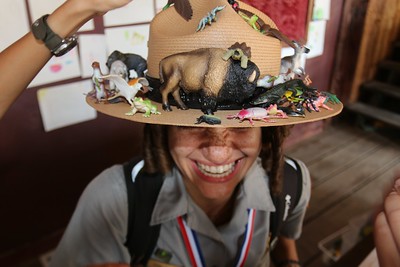Last updated: January 20, 2022
Lesson Plan
National Parks Legacy: Nature and Culture...NPS Protects Both! Grades Pre K-1

- Grade Level:
- Lower Elementary: Pre-Kindergarten through Second Grade
- Subject:
- Literacy and Language Arts,Science,Social Studies
- Lesson Duration:
- 30 Minutes
- State Standards:
- K-ESS3-3
K-HSS-6-1
1-HSS-4-3
1-HSS-5-2 - Thinking Skills:
- Remembering: Recalling or recognizing information ideas, and principles. Understanding: Understand the main idea of material heard, viewed, or read. Interpret or summarize the ideas in own words. Applying: Apply an abstract idea in a concrete situation to solve a problem or relate it to a prior experience. Analyzing: Break down a concept or idea into parts and show the relationships among the parts.
Essential Question
What is the difference between a local park and a national park? What features are protected by national parks?
Objective
1. Students will understand that the goal of the National Park Service is to protect both natural and cultural resources.
2. Students will learn the difference between natural and cultural resources.
Background
- In 1872, Yellowstone was established as America's first "public park for the benefit and enjoyment of all", later to be called a National Park.
- In 1906, Teddy Roosevelt established Mesa Verde as the first National Park intended "to preserve the works of man".
- From its beginning, the National Park Service has been charged to preserve both natural and cultural/historical places, as can be seen in the mission statement. It is currently comprised of 419 units!
- Yellowstone supports diverse wildlife, but its most iconic species is the American Bison. The bison appears in the National Park Service's emblem, worn on uniforms.
- The cliff dwellings in Mesa Verde served diverse functions, revealing living quarters, ceremonial sites, and terrace farming locations of the Ancestral Puebloan people.
Preparation
- Print the "How Times Have Changed" Handout for each student.
- Download or print a photo of the National Park Service emblem to show your class.
- Load the short videos and web pages needed for this lesson. (See 'procedure' for the links)
- If you are doing the "Assessment" or "Enrichment Activity", pass out one blank sheet of paper per student, as well as drawing materials.
Materials
Times Have Changed Handout
Download Times Have Changed Handout
National Park Service Emblem photo
Procedure
2. Go to the Kid's Wildlife page, and read about a few animals aloud as a group. Make sure that one of the animals you talk about is the bison.
3. Highlight that bison in Yellowstone are so well known that they are on the National Park Service emblem.
4. Show students a photo of the NPS emblem.
2. Play the National Geographic Video of Mesa Verde. (1:45 minutes)
3. Point out that these cliff dwellings teach us how the Ancestral Puebloan people lived.
4. Show students the Park Service emblem again. The arrowhead shape reminds us to protect culture as well as nature.
2. Ask additional students to form pairs, and continue to name examples of Yellowstone wildlife and Mesa Verde cultural artifacts and sites.
Vocabulary
- National Park: an area that is owned and maintained by the federal government because of its natural beauty or importance to history
- Bison: a large, wild animal, similar to a cow but having a larger head and hairy shoulders, found in North America
- Cliff Dwelling: housing of the prehistoric Ancestral Puebloans, built into overhangs on cliff walls
- Natural: from nature; not artificial or involving anything made or caused by people
- Cultural: referring to the way of life of a particular group of people, especially shown in their ordinary behavior and habits, their attitudes toward each other, and their religious beliefs
Enrichment Activities
Explore the meaning of additional symbols in the National Park Service emblem not included in this lesson. Encourage students to design their own emblems and share their artwork with other classes. Discuss the importance of continued protection of nature and culture, and ask students how they used symbols in their own designs to support the National Park Service goals. Find additional information regarding the NPS emblem.
Additional Resources
- Watch a two-minute film on the American Bison, created by Yellowstone National Park.
- Mesa Verde National Park's photo galleries feature a variety of cultural sites.
